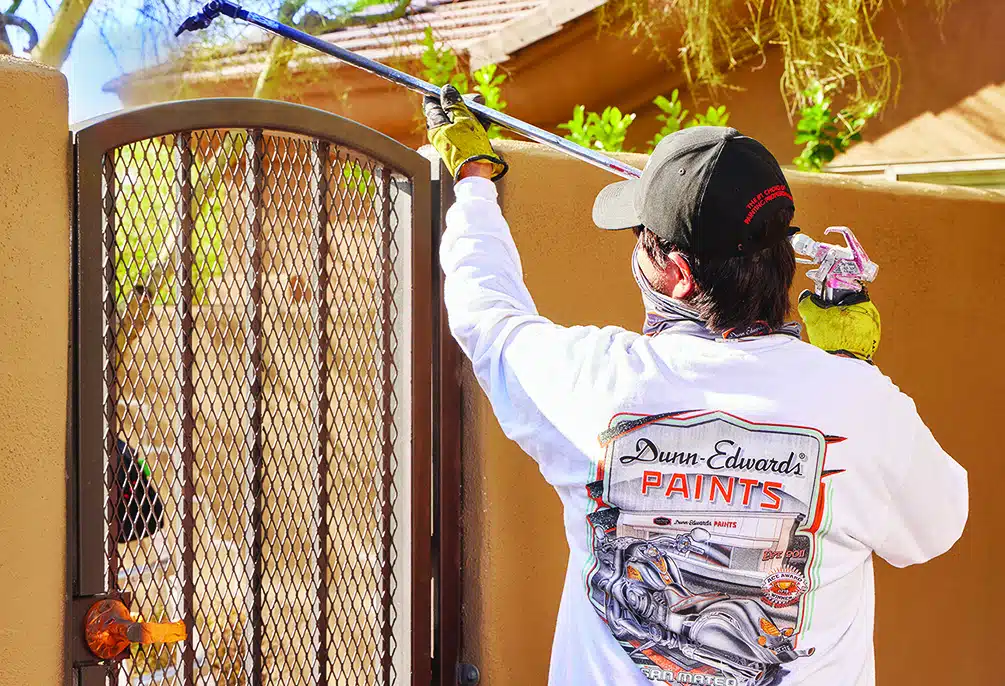5 Back-to-Safety Basics for Painting Pros
09/11/2017 | Dunn Edwards |
Are you as safe as you could be?
Painting isn't an inherently dangerous job, but sometimes getting too comfortable on the job can pose a safety threat. While most painting professionals do follow best practices, it’s easy to let familiarity blind you to potential hazards. Stay safe on the job with this list of absolute safety-musts and common hazards – and see where you could brush up on painting safety.
- Never Fear, You’ve Got Gear
As a painting contractor, wearing the right gear can make the difference between distress… and success. Check out these must-haves in personal protective equipment:
- Wear cloth or leather gloves when sanding and scraping, waterproof gloves when using water-based paint, and solvent-resistant chemical gloves when dealing with solvent-based products.
- Wear comfortable, loose-fitting clothing. Roll up or hem pants that are too long, and make sure your shoelaces are tied and out of the way.
- Use eye goggles, glasses or a facemask.
- Wear an anti-dust mask while sanding a surface or a solvent-respirator if working with solvent-based products. If you are painting with a sprayer, wear a mist filter and an organic vapor respirator to avoid inhaling paint spray.
- Ensure good ventilation by opening windows and doors.
- Power Trip No More
Power washers and spray painting equipment are invaluable tools, and are generally safe when used correctly. Here are some things to keep in mind:
- Sprayers and washers use extremely high pressure (up to 3,000 psi). Therefore, never point any of these devices at any person or animal and ensure the equipment is out of the reach of children.
- Wear appropriate clothing (long-sleeved shirts, long pants, goggles, gloves, etc.) to protect your skin in case you accidentally hit the trigger while the nozzle is near you.
- Power tools should never be plugged into a power source unless you are sure that the trigger is in the "off" position. To avoid an electrical short, don’t ever use power equipment in the rain.
- Ensure proper ventilation when working with paint coatings. A spray booth is an excellent way to remove spray paint vapors and debris from your breathing zone.
- To prevent sparking a flammable substance, smoking and other sources of flame should be banned from the vicinity of spray painting operations.
- Fall in Love with Ladder Care
Ladder fall injuries have resulted in as many as 113 fatalities and 34,000 emergency department visits in one year alone, according to a report from the Centers for Disease Control and Prevention. Although ladders are indispensable tools in the painting process, their potential for danger cannot be underestimated. Safety starts with choosing the right ladder for the job and includes regular inspection, setup, proper use, care and storage.
- Always check a ladder before use. Wood ladders need to be inspected for cracks or splits, while metal and fiberglass ladders should be reviewed for bends and breaks. Never use a damaged ladder.
- When setting up a ladder, ensure that it is positioned straight and steady on a firm, flat surface.
- Face the ladder when climbing up or down and always keep three-point contact with the ladder. Three-point contact means that at any point in time, you should have both hands and at least one foot, or both feet and at least one hand securely in contact with the ladder.
- Avoid working in wet or windy weather and do not climb a wet ladder.
- If you must place a ladder near a doorway, ensure that it is locked, blocked or guarded so that it cannot be opened while you are on the ladder.
- Never carry heavy or bulky loads up a ladder. Climb up first, then use a rope or buck to haul the items up.
- After the job is complete, be sure to properly store the ladder so it won't be subject to extreme heat or dampness and will be in good working condition for the next project.
- Engage in Safe Scaffoldery
Scaffold-related accidents result in 4,500 injuries and over 60 deaths each year, according to the US Dept. of Labor and the Bureau of Labor Statistics. Avoid becoming a statistic by following these best practices:
- Do not stand on the scaffold while it is in motion. If you must remain on the scaffold, make sure you are secured to the building with a proper safety harness and lanyard.
- Do not try to move a rolling scaffold without appropriate help. Watch out for slopes, holes, debris and overhead obstructions.
- Do not lean ladders against rolling scaffolds.
- Do not overreach from the scaffold.
- Do not climb the scaffold using the frame.
- Lift with Caution
Using lifts can be extremely helpful for painting projects but it’s important to exercise great care. The following are safety tips you need to observe when working with a lifting device:
- Before using the lift, ensure you have a level surface around the working environment. Check for holes, drop-offs, ditches and bumps and map out a possible path to avoid them. All hazards and obstacles must be cleared or avoided to maximize safety.
- Ensure there are appropriate overhead clearances.
- Because the machine isn’t insulated, there is the risk of electrocution. Keep it away from electric power lines and electrically charged conductors.
- Do not overload the device beyond its rated capacity.
- Don’t lean over or climb over the guardrails.
While being a paint contractor isn’t the most dangerous profession in the world, it is critical that you put some extra time and attention into guaranteeing that your jobsite and working habits are as hazard-free as possible. You might paint by the gallon… but to stay safe on the job, an ounce of prevention should do the trick.
Sources: OSHA, Paint Quality Institute, Centers for Disease Control and Prevention, US Department of Labor, Bureau of Labor Statistics














